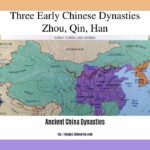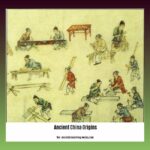Embark on a captivating journey through time as we delve into the enigmatic origins of ancient China. From meticulously examining unearthed artifacts to deciphering the secrets concealed within ancient texts, we will unravel the intricate tapestry of this extraordinary civilization. Join us as we explore [Exploring the Ancient Chinese Origins: From Artifacts to Historical Narratives], illuminating the foundations that shaped one of the world’s most enduring and influential cultures.
Key Takeaways:
- Ancient China is the oldest continuing civilization in the world.
- The term “China” originates from the Sanskrit word “Cina,” which refers to the Qin Dynasty.
- The Yellow River region in northern China witnessed the initial development of ancient Chinese civilization between the 3rd and 2nd millennia BCE.
- The Han dynasty (206 BCE – 220 CE) played a pivotal role in establishing the fundamental foundations of Chinese civilization.
Ancient Chinese Origins

Ancient Chinese origins represent the birth of a civilization dating back thousands of years. Its roots lie in the fertile Yellow River region, where early settlements thrived in the 3rd and 2nd millennia BCE.
Deciphering Ancient Narratives
Artifacts and texts from ancient Chinese origins provide invaluable clues into this period. Archaeologists decipher inscriptions, pottery, and bronzeware to piece together a detailed history. These discoveries reveal the social, economic, and cultural complexities of early Chinese society.
Cultural Foundations
By the end of the Han dynasty in 220 CE, essential foundations of Chinese civilization were in place:
- Written Language: The development of a written language, the Chinese script, facilitated communication, record-keeping, and the transmission of cultural knowledge.
- Political Structures: The rise of successive dynasties, such as the Qin and Han, established centralized governments and administrative systems.
- Technological Innovations: Advances in metallurgy, agriculture, and infrastructure laid the groundwork for future economic and societal growth.
Sanskrit and “Cina”: The Name “China”
The name “China” originates from the Sanskrit term “Cina,” which was derived from the Chinese Qin Dynasty. This reflects the influence of early cultural exchanges with India and the spread of Chinese civilization beyond its borders.
Chronological Table: Key Periods in Ancient Chinese History
| Period | Time Frame | Key Events |
|---|---|---|
| Neolithic Age | 5000-2000 BCE | Agricultural development, pottery, and early settlements |
| Bronze Age | 2000-1000 BCE | Metallurgy, bronzeware production, and social stratification |
| Shang Dynasty | 1600-1046 BCE | First centralized state in China, written language, and bronze ritual vessels |
| Zhou Dynasty | 1046-256 BCE | Feudal system, development of philosophy, and cultural advancements |
| Qin Dynasty | 221-206 BCE | Unification of China under the First Emperor, standardized writing and currency |
| Han Dynasty | 206 BCE – 220 CE | Expansion of Chinese territory, Silk Road trade, and cultural golden age |
To know more about the history of kites, visit now and explore the captivating journey of kites through the ages!
Unleash your passion for the skies and immerse yourself in the vibrant colors and exhilarating atmosphere of kite festivals! Witness the artistry and craftsmanship of kites from around the world as they dance gracefully in the wind.
Deciphering Ancient Chinese Texts and Artifacts

Imagine stepping back in time to uncover the enigmatic world of ancient China through its artifacts and texts. These relics whisper tales of a civilization rich in culture, innovation, and spiritual beliefs.
Cracking the Code of Oracle Bones
Oracle bones, inscribed with ancient Chinese characters, offer tantalizing glimpses into the Shang Dynasty (1600-1046 BCE). Deciphering these texts has revealed intricate divinatory practices and provided insights into the social and religious beliefs of the time. Despite ongoing research, only about a third of these characters have been deciphered, leaving much of their story yet to be told.
Unveiling the Secrets of the Silk Manuscript
Another treasure, the Silk Manuscript, dates back to the Warring States period (c. 475-221 BCE). Written on silk, it contains texts that illuminate ancient Chinese religious beliefs, including Confucianism and Daoism. Deciphering these texts has helped scholars understand the diversity and complexity of Chinese thought.
Key Takeaways:
- Ancient Chinese texts and artifacts hold invaluable information about the origins and development of Chinese civilization.
- Deciphering these texts and artifacts requires specialized knowledge and collaboration between archaeologists, historians, and linguists.
- Ongoing research continues to uncover new understanding of ancient Chinese society and culture.
Sources:
- Decoding 3,000-Year-Old Inscriptions on Bones
- Ancient Chinese Silk Manuscript Confirms Confucianism’s Core Values, Beliefs
Cultural and social aspects of ancient Chinese society
Imagine stepping back in time to the ancient land of China, a cradle of civilization that has captivated historians and anthropologists for centuries. Ancient Chinese society was a vibrant tapestry woven with unique cultural and social threads that shaped its destiny.
Family and Social Structure
The foundation of ancient Chinese society lay in the family, which was the basic unit of society. The extended family system prevailed, with several generations living under one roof. Respect for elders and ancestors was paramount, and filial piety was a cornerstone of social order.
Religion and Beliefs
Ancient Chinese beliefs were a complex blend of animism, shamanism, and ancestor worship. They believed in a pantheon of gods and spirits that controlled the forces of nature and human affairs. Rituals and ceremonies played a vital role in appeasing these deities and ensuring harmony.
Social Hierarchy and Class Structure
Chinese society was highly stratified, with a rigid hierarchy based on birth and occupation. The ruling class, consisting of the emperor and his court, occupied the top of the ladder. Below them were the nobles, officials, landowners, merchants, artisans, and peasants.
Education and Literacy
Education was highly valued in ancient China, and the elite had access to advanced education in subjects such as classics, history, and philosophy. The invention of writing and the development of a script allowed for the recording and transmission of knowledge, contributing to the advancement of science and culture.
Key Takeaways:
- Family and social structure emphasized the extended family and filial piety.
- Religion and beliefs blended animism, shamanism, and ancestor worship.
- Social hierarchy and class structure divided society into a rigid system based on birth and occupation.
- Education and literacy were highly valued, particularly among the elite.
Citation
- Ancient Chinese Civilization
- Culture and Society in Ancient China
Influence of ancient Chinese civilization on global history
Key Takeaways:
- Continuous academic traditions: China’s uninterrupted scholarship since ancient times has preserved and transmitted knowledge, influencing global intellectual pursuits.
- Humanistic spirits: Ancient Chinese philosophy, particularly Confucianism and Taoism, emphasizes humanism, ethics, and harmony, shaping global values.
- Confucianism, Taoism, and Buddhism as major influences: These spiritual practices have profoundly influenced global religions, philosophies, and ethical systems.
- Artistic and cultural forms: Ancient Chinese art forms like dance, poetry, and hymns have inspired and been adopted by cultures worldwide.
- Intellectual traditions foundational for Chinese politics, education, and art: Chinese intellectual traditions, including Confucian teachings, have influenced political institutions, education systems, and artistic practices globally.
In terms of its influence on global history, ancient Chinese civilization stands as a testament to human ingenuity and creativity. Its advancements in various fields have left an indelible mark on the development of global cultures and societies. Through its contributions to philosophy, religion, art, literature, science, and technology, ancient China has shaped the course of human civilization and continues to inspire and influence us today.
Sources:
- Disentangling the Cultural Evolution of Ancient China
- How China’s ancient civilization links to the world today
FAQ
Q1: What are the origins of the name “China”?
Q2: What are the key characteristics that define ancient Chinese civilization?
Q3: What were some of the significant contributions of ancient Chinese culture?
Q4: How have archaeological discoveries, such as the Oracle Bone Inscriptions, contributed to our understanding of ancient China?
Q5: What is the significance of the Silk Manuscript in shedding light on ancient Chinese religious beliefs?
- Unlock 6000+ words beginning with he: A comprehensive analysis - April 20, 2025
- Mastering -al Words: A Complete Guide - April 20, 2025
- Master Scrabble: High-Scoring BAR Words Now - April 20, 2025
















